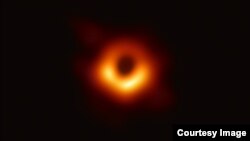Using eight radio telescopes literally spanning the globe, scientists have taken the first-ever photograph of a black hole.
The supermassive black hole is at the center of a huge galaxy called M-87, which is 55 million light-years from Earth.
The picture, the result of decades of work by the Event Horizon Telescope Collaboration (EHTC), isn't much to look at. It's a fuzzy orange and yellow donut floating in space, but the implications for physics, and the incredibly intricate way that researchers got the picture, is science at its best.
The picture is exactly what scientists, particularly the late Albert Einstein, predicted it would look like. There is the eponymous center black hole where gravity is so powerful even light cannot escape, and a circular area of superheated energy rotating around the celestial entity at nearly the speed of light, called the event horizon.
"We now know that a black hole that weighs 6.5 billion times what our sun does exists in the center of M-87," EHTC scientist Shep Doeleman announced at a press conference Wednesday in Washington. "And this is the strongest evidence that we have to date for the existence of black holes."
This picture is so important because while scientists have been seeing the effects that black holes have on the structures around them, they have never actually seen one, and this photo in effect proves their existence, as well as one of the foundational principles of Einstein's theory of general relativity.
200 scientists
At its center, the black hole is so big that even though it's a long distance away, scientists reasoned it was likely to be the largest such structures viewable from Earth. For that reason, M-87 was chosen for the experiment.
More than 200 scientists worked for about a decade to link the global network of eight radio telescopes, using atomic clocks. One by one in an exact sequence, the instruments were pointed at M-87 at what was, in effect, the same time, back in April 2017.
When the experiment was over, the researchers had five petabytes — or a million gigabytes — of visual information to review. At the press conference, researchers told the story about how it was much quicker to take the data by plane to the various supercomputers being used to analyze the information. They said this was easier than trying to transfer that much data into the cloud.
It took two weeks for a group of supercomputers to analyze the data and begin to form all the collected information into the modest photo that scientists released Wednesday.
And once that photo was collected, the researchers waited two years to publish their data while scientists from all over the world checked their work and signed off on the idea that what was photographed was actually a black hole.
What happens now?
The team isn't done, though. They already are planning to create even bigger telescopes than the Earth-sized one they used by incorporating space telescopes like the Hubble and the soon-to-be-launched James Webb Space Telescope. This should allow researchers to take photos of dozens of other black holes.









